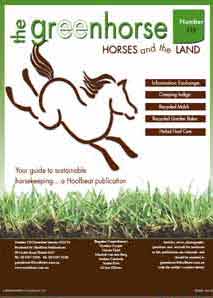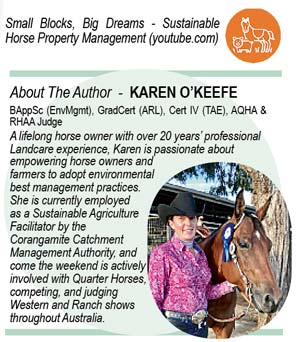The Green Horse section provides practical information on managing environmentally sustainable horse properties, readers stories and tips, as well as advice and articles from equestrian experts in their fields.
June July 24
Vol 46 No 1
In this issue of The Green Horse you will find the following articles
DROUGHT, FLOOD AND MUD
Australia has it all. Paddocksthat are looking parched mere months ago didn't take long t become wet and soggy, and those that had barely time to recover from floods and above average rainfall soon had muddy, boggy areas return.
EQUINE LANDCARE GROUPS
For horse owner, joinging an Equestrian Landcare group offers not only an opportunity to contribute to enviramental conservation but also to enhance their own land's utility and ensure the well-being of their horses.
SMALL BLOCKS BIG DREAMS
by Karen O'Keefe
An example of how sme small landcaregroups also deliver Equine Landcare related activities.
PRUDENT PRUNING
For equestrian property owners, the management of trees around stables and other infrastructure is not just about aesthetics; it’s about safety, health, and maintaining functional spaces. Properly trimming trees can prevent accidents, improve accessibility, and even enhance the health of the horses and people who use these areas.
WIN A YEAR'S SUBSCRIPTION...
share your equine property management tips and each issue one reader will win.
Send ideas to -
The Green Horse Support <enquiries@hoofbeats.com.au>


PREVIOUS ARTICLES
Available on line
February March 24
CAN A SOIL TEST TELL YOU WHAT IS IN YOUR PASTURE?
by Nerida Richards - Feed XL
A definite recommendation for horse owners is to have their pasture and hay tested so they get a much more accurate idea of what their horses are eating.
August September 23
CREATING AND USING THE SACRIFICE PADDOCK
Functional areas that are safe and useable are essential, with an area set aside as a ‘sacrificial’ area or paddock considered by many horse owners to be an invaluable component of their property’s set up and design.
June July 23
CREATING A WEED MANAGEMENT PLAN - your property your weeds.
by Rhiannon Brown, Envirapest
Keep it Simple as making a weed management plan doesn’t have to be like studying for that master’s degree or passing your driving test for the first time either.
Apriil/May 23
SIMPLE FEED BUDGET
by Belinda Taylor
Although most horse owners are nervous at the prospect of creating a budget, a few quick
calculations can give you the power to compare prices and alternatives that can reduce your horses’ feed
costs, without impacting on their health and wellbeing.
February/March 23
CROFTON WEED KILLS HORSES
by Angela Davison
If you have this weed on your property then it is best to not have any horses in the paddock until such time as you can eradicate it.
December/January 22 23 PROPERTY PLANNING
-Working with your property- not against it.
by Teele Worrell
Property planning is about
using your property effectively
and efficiently and sometimes
starting with a clean slate.
October/November 22
WHAT IS EQUESTRIAN LANDCARE
by Teele Worrell
Part 1 In a series in which Teele will explore what equine landcare is, and why it benefits equine landholders
August/September 22
THE IMPORTANCE OF GROUND COVER
by Belinda Taylor
Ground cover, whether it be dead grass, weeds, hay, or mulch is the insulating layer that protects your soil from the extremes of temperature and erosion.
June/July 22
SOLAR FOR YOUR ARENA
Environmentally-friendly solar lighting for your arena will allow you to use your arena for longer, and as energy from the sun is free it is therefore an ideal long-term solution for powering lights. Jeff Florence from Blackfrog Solar, Queensland suggsted some solar tips.
April/May 22
MAKING THE MOST OF MOSQUITO CONTROL
by Rhiannon Brown - Envirapest
Climate change that has brought high temperatures, more rain and increases in humidity will provide ideal breeding grounds for the many species of mosquitoes, including those that spread the Japanese Encephalitis virus (JEV).February/March 2022
February/March 22
SUSTAINABLE DEWORMING
by Sophie Fletcher
There has been a relatively big shift in deworming treatment strategies in recent years, due to increasing levels of worm resistance to the chemicals we have been using for decades to control them, resulting in a lot of confusion among horse owners.
December/January 21/22
ARE YOU PREPARED FOR THE FIRE SEASON
In the many areas where horse owners live this season's fire preparation should be well underway; if you’ve not already started preparing your property for summer then now is the time to do so.
October/November21
SNAKE UNIVERSAL ANTIVENOM
The good news is that there is no longer any need for a snake to be identified to administer antivenom. A universal antivenom is now used that covers the five genus of snake that will cause serious harm or death.
August/September 21
BEAT THE BINDI
by Rhiannon Brown - Envirapest
The prickly weeds that grow on our properties across Australia usually have long classical Latin names, are often known by a variety of common names in different localities but are regularly called very rude names when we happen to stand on one (or a dozen) or when they find our hands as we are dislodging tangles in the horse’s mane or tail.
June July 21
BARN OWLS by Wendy Elks
A silent partner in rodent control.
Non-toxic pest management is the most humane and ecologically sustainable way of bringing nature back into some kind of balance during non-plague times.
April/May 21
LOVELY LAWNS
by Rhiannon Brown - Envirapest
On a horse property there always seems to be hectares of grass, but we all have that little bit of lawn we want to look luscious all year round.
It could be the entrance to the stables, laneways bordering the driveway, that little ‘special’ snack paddock or you could even dream of a beautiful green arena. So, how do we achieve this?
Feb/March 21
STABLE DANGERS
by Elizabeth Tollarzo
They say that horses are accidents-waiting-to-happen as they are inclined to find every conceivable way to injur themselves, usually just before a competition. Being aware of potential dangers in the stable - and addressing these - may help aleiviate injury.
Dec/Jan 20/21
HORSES AND HONEY BEES-
Can they share space on the property?
by Wendy Elks
Oct/Nov 20
SOLAR-POWERED PRODUCTS
by Celine Bønnelykke
In previous issues we have discussed the economics of setting up a solar-driven property, but if finances don’t stretch to installation of the whole package, there are ways to ease into the solar-world.
Aug/Sept 20 THE HIDDEN DANGERS IN OUR PADDOCK.
by Elizabeth Tollarzo
Horses love to run, play, buck and then run again and we often, through lack of risk assessment or management practices, place them in areas that are fraught with dangers.
JUNE JULY 20 GOING SOLAR ON THE HORSE PROPERTY Where to put your panels Part 2
Once you have selected what solar system best suits your needs, then you need to look at how you can maximise the advantages.
APRIL MAY 20 GOING SOLAR ON THE HORSE PROPERTY Part 2
Once you have selected what solar system best suits your needs, then you need to look at how you can maximise the advantages.
FEB/MARCH 20 ANTS AWAY
by Mark Brown Envirapest
So, what can you do to deter ants from your house and your stables??
DJ19/20 KEEPING SNAKES OUT OF THE STABLE by Wendy Elks
Snakes may be protected under Wildlife regulations in Australia, and they may be great for keeping the mice and rats down, but do we want to find them in our stables near our horses and pets?
ON19 - TERMITES- common myths
by Rhiannon Brown, Envirapest
Your house and stables are looking wonderful this spring, but do you know what is happening inside the walls of your brick or timber building?
AS19 - OUCH THAT HURTS
by Catherine Bird for Country Park Saddlery
The extent of the swelling is usually an indication of the severity of the infection or injury and the cause needs to be established before giving herbs.
JJ19 - MANAGING PASTURE
by Rhiannon Brown, Envirapest Healthy pasture means healthy horses.
A/M19 - STOP THOSE WEEDS
Property biosecurity
by Rhiannon Brown, Envirapest
Putting simple precautionary steps into place can make it tough for weeds to get a hold on your equine paradise.
|
  
  


Small Blocks Big Dreams is a land stewardship program delivered by Upper Barwon Landcare Network in 2023 / 2024, with support from the Corangamite Catchment Management Authority (CMA) and funding through the Victorian Government.This program - which involves a series of five tailored workshops, property visits and one-on-one advice - supports small property owners in learning about environmental best management practices. The learning focused on the relationship between healthy land and healthy horses, including how to integrate natural horse behaviours into property design and land management.
A working group consisting of local horse owners and representatives from Landcare and Government agencies helped design a workshop specifically for horse owners, which saw a group of over 30 horse owners from around Geelong, Ballarat and Colac participate in the Small Blocks Big Dreams horse program. Topics covered included soils, pastures and grazing management, weeds, biodiversity and native vegetation, horse health and nutrition, biosecurity, climate change and fire preparation, equiculture and property planning.
An introductory session held at Red Gum Arena, Freshwater Creek near Geelong, included a Wadawurrung Traditional Owner Welcome to Country, followed by a presentation from Kathy Gabriel, a regenerative beef farmer, Mongol Derby participant, photographer, and horse owner.
Session two was delivered by international Equiculture speaker and author Stuart Myers who provided an overview of horse health, natural horse behaviours, animal welfare, grazing management for pasture and soil health, manure and parasite management, and property designs for healthy horses and healthy land.
Karen O’Keefe from Corangamite CMA presented session three focusing on soils, pastures and grazing management, and the relationship between soil and common species. The multiple benefits of incorporating habitat for native plants and animals was also discussed. This was followed by a horse property visit to see horse property designs in practice, including a hybrid paddock paradise and equiculture system where horses live as a herd and paddocks are rotationally grazed. A plant ID session was held in the paddock to identify native and introduced grasses, weeds, trees and shrubs.
Session four was about understanding horse nutrition with specialist Samantha Potter from FeedXL. Horse welfare and health was discussed by workshop host Amanda Edwards, owner of the Equine Care Clinic near Ballarat, where the session was held. A biosecurity session was also included with Agriculture Victoria discussing disease and weed risk mitigation strategies for horse properties.
The final session covered the effects of climate change on local weather and the relationship between fire behaviour, and tips on how to manage fire preparation from a Country Fire Authority representative. Attendees learnt how to develop their own property plan using the Corangamite CMA ‘My Property’ NRM Portal tool, where you can also look up soil, water, native vegetation and other information including aerial imagery, and participants began to develop their own My Property Action Plan. The session concluded at a horse property near Ballarat to see changes that had been made by Small Blocks Big Dreams program participants including hard standing gravel gateways and rotational grazing using a laneway system.
Upon completing the Small Blocks Big Dreams land stewardship course participants received:
Support to develop a land stewardship action plan for their own property
An aerial image of their property
A site visit with expert land management knowledge
Eligibility for land management incentive money based on their new action plan
Contacts for other potential support to assist with implementing their action plan.

|